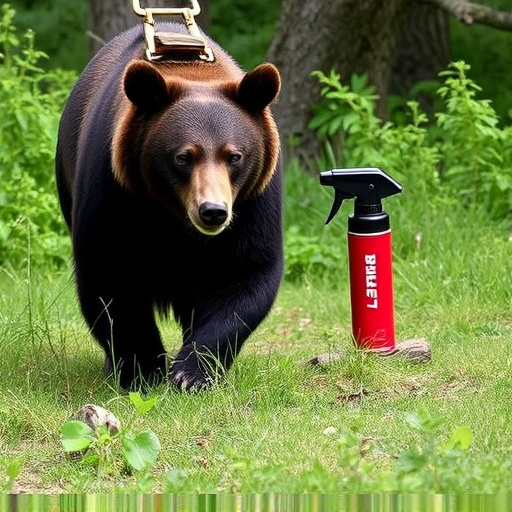Grizzly bears rely heavily on scent detection for navigation and prey location. Bear spray is a crucial self-defense tool against grizzlies, effective when used correctly with high-concentration capsaicin. Understanding wind direction is vital: aim slightly upwards towards potential threats, keeping the spray nozzle away from you. Master safety techniques like 'stop, drop, and roll' to enhance confidence in grizzly country, ensuring bear spray remains effective during unpredictable winds.
In the vast wilderness, encountering a charging grizzly bear is a chilling yet realistic possibility. Understanding bear behavior and employing effective safety measures are key to navigating these encounters. This article guides you through essential strategies, focusing on bear spray usage, wind direction considerations, and critical safety tips for high-risk situations. Equip yourself with knowledge to confidently face potential threats in the wild, ensuring your survival and peace of mind.
- Understanding Grizzly Bear Behavior and Motivation
- Choosing and Applying Bear Spray Effectively
- Mastering Safety Tips in High Wind Conditions
- Navigating Unpredictable Wind Direction for Protection
Understanding Grizzly Bear Behavior and Motivation
Grizzly bears, or Ursus arctos horribilis, are powerful and formidable creatures that inhabit remote wilderness areas across North America. Understanding their behavior and motivation is crucial for anyone venturing into bear country. These bears are primarily motivated by food, especially during certain times of the year when they need to build up fat reserves for hibernation. They possess a keen sense of smell, making scent detection a key aspect of their navigation and prey location. This means that carrying and using bear spray effectively can be a game-changer in deterring an attack, as it disrupts their olfaction.
Knowing the wind direction is another vital safety tip when hiking or camping in grizzly bear habitats. Bears have excellent hearing, so they can detect sounds from long distances. When moving through bear country, stay upwind of potential bear locations to avoid raising your scent and making unexpected noises that might startle them. Bear behavior can vary, but generally, they aim to avoid humans unless they feel threatened or are protecting their young. By being aware of these factors and following safety guidelines, you can minimize the risk of encountering a grizzly bear and enhance your overall wilderness experience.
Choosing and Applying Bear Spray Effectively
When it comes to defending yourself against a charging grizzly bear, bear spray is a crucial tool. Choosing the right type is essential; look for a can with a high concentration of capsaicin, the active ingredient that deters bears. Ensure you practice using it before your trip to familiarize yourself with application techniques.
Bear spray should be aimed at the bear’s face and eyes, as this is where it will cause the most discomfort. Always remember the wind direction; you want the spray to land on the bear, not blow back onto you. Safety tips include keeping your back against a barrier, like a tree or rock, and using the ‘stop, drop, and roll’ technique if the spray doesn’t work or you’re knocked down.
Mastering Safety Tips in High Wind Conditions
In high wind conditions, understanding how bear spray performs becomes crucial for your safety in the wilderness. Wind direction plays a significant role; always keep the spray nozzle facing away from you and towards potential threats. Aiming upwards slightly can help ensure the spray reaches the bear effectively. Regularly checking the weather forecast before heading into grizzly country is wise, allowing you to prepare accordingly with extra precautions on breezy days.
Mastering safety tips like these enables you to navigate high-risk environments more confidently. Bear spray is a vital tool when faced with an aggressive charge, but proper usage techniques and awareness of environmental factors are essential for its effectiveness. Always follow safety guidelines, be mindful of wind patterns, and stay prepared in the event of unexpected encounters.
Navigating Unpredictable Wind Direction for Protection
Navigating unpredictable wind direction is a critical aspect of enhancing safety tips for bear spray usage against charging grizzly bears. Understanding wind patterns can significantly impact the effectiveness of bear spray, as it dictates where the mist will travel and settle after spraying. Since grizzlies have an excellent sense of smell, aiming for their faces while considering the wind direction ensures direct contact with irritants in their nostrils and eyes, temporarily disorienting them.
When the wind is blowing away from you, it’s generally safer to spray as it reduces the risk of inhalation by you and increases the likelihood of mist reaching the bear’s face directly. Conversely, if the wind is coming from behind or towards you, it may carry the spray back towards you, potentially making it ineffective against the charging bear. Therefore, always be mindful of the wind direction for optimal safety when using bear spray in grizzly country.
When faced with a charging grizzly bear, understanding their behavior and utilizing safety tips like effective bear spray application and navigating wind direction can significantly enhance your protection. Remember, knowing how and when to deploy bear spray is crucial, especially in high wind conditions. By mastering these techniques, you’ll be better equipped to navigate unpredictable scenarios and ensure your safety in the wilderness. Always stay alert, respect wildlife, and embrace proactive measures to minimize encounters with aggressive bears.
